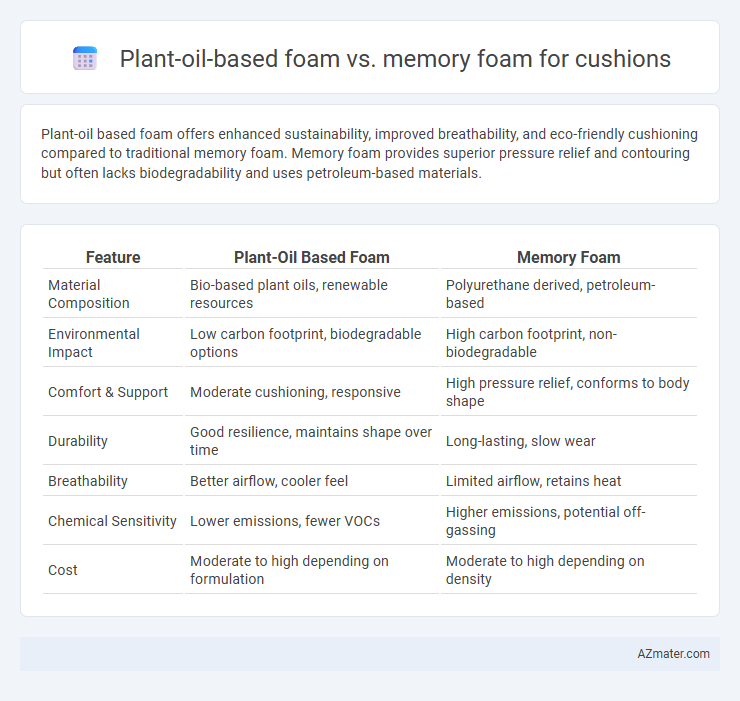Plant-oil based foam offers enhanced sustainability, improved breathability, and eco-friendly cushioning compared to traditional memory foam. Memory foam provides superior pressure relief and contouring but often lacks biodegradability and uses petroleum-based materials.
Table of Comparison
| Feature | Plant-Oil Based Foam | Memory Foam |
|---|---|---|
| Material Composition | Bio-based plant oils, renewable resources | Polyurethane derived, petroleum-based |
| Environmental Impact | Low carbon footprint, biodegradable options | High carbon footprint, non-biodegradable |
| Comfort & Support | Moderate cushioning, responsive | High pressure relief, conforms to body shape |
| Durability | Good resilience, maintains shape over time | Long-lasting, slow wear |
| Breathability | Better airflow, cooler feel | Limited airflow, retains heat |
| Chemical Sensitivity | Lower emissions, fewer VOCs | Higher emissions, potential off-gassing |
| Cost | Moderate to high depending on formulation | Moderate to high depending on density |
Introduction: Understanding Cushion Materials
Plant-oil based foam cushions offer a sustainable alternative to traditional memory foam by utilizing renewable, bio-based materials derived from vegetable oils. Memory foam, primarily made from polyurethane with added chemicals, provides superior pressure relief and contouring support due to its viscoelastic properties. Understanding the environmental impact and comfort performance of these materials helps consumers make informed choices for eco-friendly and ergonomic seating solutions.
What is Plant-Oil Based Foam?
Plant-oil based foam is an eco-friendly alternative to traditional memory foam, produced by substituting a portion of petroleum content with renewable plant oils such as soy or castor oil, improving its biodegradability and reducing environmental impact. This bio-based foam maintains comparable comfort and support characteristics to memory foam, providing pressure relief and durability while enhancing sustainability. It is increasingly popular in cushions and mattresses due to its reduced carbon footprint and potential for hypoallergenic properties.
What is Memory Foam?
Memory foam is a viscoelastic polyurethane material known for its high density and ability to conform to body shape by responding to heat and pressure, providing excellent support and pressure relief. Plant-oil based foam incorporates renewable plant oils into the foam structure, enhancing environmental sustainability while maintaining comfort and durability comparable to traditional memory foam. This bio-based alternative reduces reliance on petroleum, offering an eco-friendly cushion option without compromising the signature contouring and motion isolation properties of memory foam.
Environmental Impact: Plant-Oil vs Memory Foam
Plant-oil-based foam cushions significantly reduce environmental impact by using renewable resources, lowering greenhouse gas emissions, and enhancing biodegradability compared to traditional memory foam made from petroleum-based polyurethanes. The production of plant-oil foam involves less reliance on fossil fuels and results in reduced carbon footprint, aligning with sustainable manufacturing practices. Memory foam cushions persist longer in landfills due to slow decomposition rates, whereas plant-oil foams offer improved end-of-life disposal options, minimizing ecological damage.
Comfort and Support Comparison
Plant-oil based foam cushions offer enhanced breathability and eco-friendly comfort, adapting well to body contours while maintaining firmness for support. Memory foam cushions conform closely to the body, providing superior pressure relief and personalized support, but may retain heat. Both foams balance comfort and support effectively, with plant-oil foam excelling in ventilation and sustainability, whereas memory foam excels in contouring and pressure distribution.
Durability and Longevity
Plant-oil based foam offers superior durability compared to traditional memory foam, resisting compression and wear over extended use periods. Its bio-based composition enhances resilience, maintaining structural integrity and comfortable support for years without significant deterioration. Memory foam tends to soften and lose shape faster, while plant-oil foams provide longer-lasting cushioning performance ideal for high-use furniture applications.
Health and Allergen Considerations
Plant-oil based foam cushions tend to have lower levels of volatile organic compounds (VOCs) and off-gassing compared to traditional memory foam, reducing indoor air pollution and potential respiratory issues. These foams often use natural oils like soy or castor, which can minimize exposure to synthetic chemicals linked to allergies and skin irritations. Memory foam may harbor dust mites and allergens if not properly maintained, while plant-oil based foams are often more resistant to microbial growth, benefiting individuals with asthma or sensitive skin.
Cost and Affordability
Plant-oil based foam cushions typically offer a more affordable alternative to memory foam, with production costs benefiting from renewable resources and simpler manufacturing processes. Memory foam tends to be more expensive due to its specialized polyurethane composition and longer curing times. Consumers seeking eco-friendly cushioning solutions often find plant-oil based foams provide a cost-effective balance between comfort and sustainability.
Ideal Uses for Plant-Oil Based Foam and Memory Foam
Plant-oil based foam excels in environmentally friendly cushioning, offering superior breathability and resilience, making it ideal for outdoor furniture, eco-conscious consumers, and areas requiring temperature regulation. Memory foam provides exceptional contouring and pressure relief, best suited for mattresses, ergonomic chair cushions, and applications needing personalized support. Both materials offer distinct advantages aligned with their chemical compositions and intended ergonomic purposes.
Conclusion: Which Foam is Best for Cushions?
Plant-oil based foam offers eco-friendly benefits with improved breathability and biodegradability, making it a sustainable choice for cushions. Memory foam provides superior contouring and pressure relief, enhancing comfort and support in seating applications. Choosing the best foam depends on prioritizing sustainability or comfort, with plant-oil based foam excelling in environmental impact and memory foam leading in ergonomic performance.

Infographic: Plant-oil based foam vs Memory foam for Cushion
 azmater.com
azmater.com